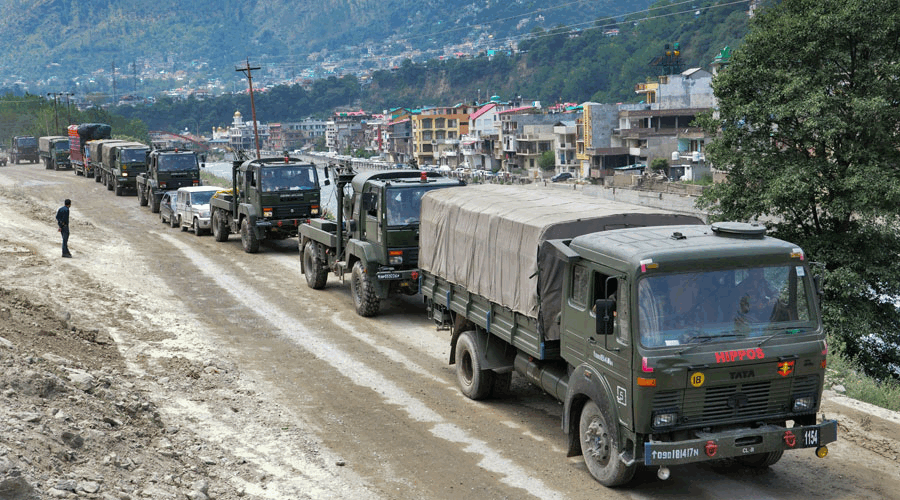The long-standing military standoff between India and China in the eastern Ladakh regions of Depsang and Demchok has recently entered a crucial phase as both countries commenced a disengagement process.
This development is a promising sign of eased tensions along the Line of Actual Control (LAC), following four and a half years of heightened military presence and conflict since April 2020.
The resolution, which involves dismantling temporary structures and resuming traditional patrolling, reflects a new phase of cooperation between the two neighboring nations. As the situation on the ground transforms, military and diplomatic efforts continue to pave the way toward a more stable LAC.
Key Developments in the Disengagement Process
The disengagement process officially began on October 22, marking a significant milestone in the de-escalation efforts along the LAC. Both Indian and Chinese forces have started to dismantle temporary structures, including tents and barriers, in the Depsang and Demchok areas, which had been established during the prolonged standoff.
According to Army sources, these dismantling activities are part of a larger agreement reached between India and China, aimed at restoring traditional patrolling rights for both nations.
Read : China’s First Reaction to Ladakh Truce with India: ‘Reached a Solution’
To ensure that the disengagement process is thorough and mutually agreeable, both armies are set to conduct a joint verification of the areas where structures are being removed. Commanders from both sides will oversee this verification on the ground, after which an aerial survey will be conducted.
This meticulous approach underscores the commitment of both nations to a transparent and coordinated resolution to the standoff. Lieutenant General M.V. Suchindra Kumar, who leads India’s Northern Command, emphasized that this process is the result of sustained diplomatic and military discussions focused on achieving a state of equal and mutual security along the LAC.
Read : Demands of Sonam Wangchuk That Prompted His 21-Day Fast in Ladakh
As the disengagement progresses, both armies have established new protocols for their activities in sensitive zones. These measures, which include prior notification of patrols, are intended to prevent future misunderstandings and potential conflicts in this strategically important region.
With plans for traditional patrolling to resume by the end of the month, this cooperative approach reflects a concerted effort to maintain peace and prevent future tensions.
Resuming Traditional Patrolling and Grazing Rights
The resumption of traditional patrolling and grazing rights in eastern Ladakh is a significant step forward in the normalization process. For decades, India and China have had shared and recognized practices for patrolling specific zones along the LAC, which were disrupted by the standoff that began in April 2020.
The escalation of tensions led to restricted access for local communities and armed forces, particularly affecting the routine patrolling and grazing practices in the Depsang and Demchok regions.
With the disengagement process now underway, both countries are preparing to restore these rights, which is expected to bring relief to local residents and reduce the presence of military forces in the area.
The recent agreement, which was reached through ongoing dialogues between Indian and Chinese officials, establishes a framework for managing patrolling activities in a way that reduces the risk of unexpected encounters or confrontations.
One of the significant elements of this framework is the mutual understanding that patrolling will be conducted with prior notification to the other side. This procedural change is intended to reduce friction by preventing accidental trespassing or unintentional shows of force that could otherwise escalate into larger conflicts.

For the local communities, who rely on these areas for seasonal grazing, the resumption of access to these regions brings a sense of normalcy and security. The engagement of both governments in addressing local concerns highlights the importance of civilian considerations within military and diplomatic discussions.
As the disengagement process unfolds, the successful restoration of traditional patrolling and grazing rights may serve as a model for other regions along the LAC, where similar agreements could be established to promote peace and stability.
Diplomatic and Military Consensus: A Path Forward for LAC Stability
The current disengagement is the result of prolonged diplomatic and military negotiations between India and China, which have been ongoing since the onset of the standoff.
Foreign Secretary Vikram Misri has noted that the recent agreement on patrolling arrangements represents a critical step toward resolving tensions that began over four years ago. Throughout this period, India and China have engaged in numerous discussions aimed at reducing the potential for conflict while upholding the principles of sovereignty and security.
This engagement has culminated in a consensus that emphasizes equal and mutual security as the basis for any sustainable agreement along the LAC.
In recent years, the focus has shifted from short-term de-escalation measures to a more comprehensive approach to managing border security. This includes not only traditional military considerations but also diplomatic exchanges that prioritize stable, long-term solutions for border management.
According to Lieutenant General M.V. Suchindra Kumar, both nations have arrived at a “broad consensus” that aims to balance the interests of both sides while allowing for routine interactions to continue along the LAC.
By establishing a cooperative framework, both India and China are working to minimize the potential for future standoffs and to build trust in the ongoing disengagement process.
The future stability of the LAC largely depends on the sustained implementation of these agreements. With the completion of the disengagement in Depsang and Demchok, and the return of joint verification protocols, the two countries are setting a precedent for managing border issues peacefully.
The disengagement, if successful, could lead to further discussions on other points of contention along the LAC and may encourage additional diplomatic measures that contribute to regional stability.
With both nations committed to open lines of communication, there is optimism that this recent disengagement may mark the beginning of a new era of reduced tensions and increased cooperation.
let’s enjoy few years on earth with peace and happiness….✍🏼🙏

